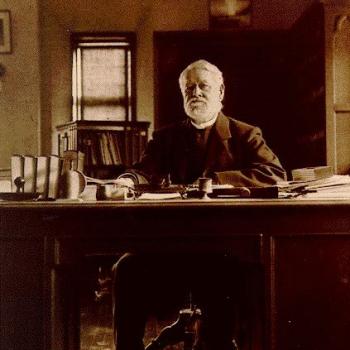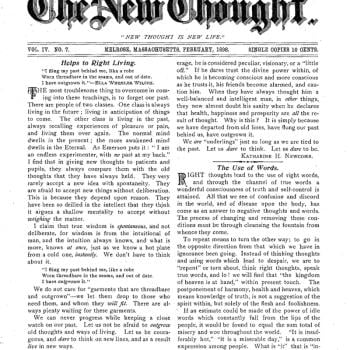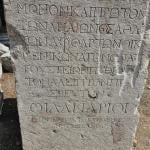Over the past few weeks, I have been posting about the Book of Mormon, and you can check out those various items as you wish.
Not surprisingly, my posts called forth a sizable number of comments and reactions, many quite intense, and a small number abusive and obscene. Here, though, I would like to react to some of the more substantial arguments, as I think they say a lot about modes of religious thinking and argument generally, rather than anything specific to Mormons. Many of these comments apply just as strongly to debates over (for instance) wacky claims about alternative gospels.
In no particular order:
*Most non-academics have a thorough lack of understanding about how academics work, or how to judge whether particular argument is bizarre and flaky, as opposed to credible. There is no sense, for instance, of why issues like peer review matter so much. Academics can and must do a much better job of explaining these things. That is all the more important given the efflorescence of junk science and junk history on the Internet and on cable channels offering breathless documentaries. My comments in these posts have been an attempt to begin to supply this need.
*Specifically, most non-academics have a very poor idea of how history and archaeology actually work as disciplines, and here is why that matters in the Mormon context. There are many fields about which I know nothing – say, the biology of bees – but that does not matter, as I never attempt to write or speak on those issues. Generally, apologists writing about the Book of Mormon know as little about authentic historical or archaeological methodology as I do about bees, but that does not prevent them making statements about history and archaeology.
It’s hard to explain to anyone with an academic background just how fundamental that ignorance is. Clearly, some commenters were mystified when I referred to pottery as a crucial material gauge by which cultures might be traced and observed. That is something you encounter on day one of a college course in archaeology.
*That comment applies with special force to genetics. Commenters again have made statements that demonstrate total ignorance about this issue, which is central to any attempt to understanding migrations or the history of ethnic groups.
The Book of Mormon describes the movement of Middle Eastern populations to the pre-Columbian Americas – and not just one wave, but repeated movements. If such an event had ever occurred, even if each were on a numerically tiny scale, it would have left a Middle East-related genetic signature traceable among modern native populations in North or South America, or both. No such trace has ever been found. And no, the genes of a small minority population do not get washed out of the system over time to the point where they can no longer be detected. (Sorry to make such an obvious point, but I have seen that view expressed).
Genetic evidence destroys the Book of Mormon’s claims to literal historicity so totally as to make any other debates irrelevant and unnecessary.
If you don’t think that’s correct, then please give me the genetic evidence you find convincing, drawing (of course) only from refereed journals. I make one plea. Before wasting my time and yours digging up discredited theories about mitochondrial haplogroup X, you might want to review the story of the Mal’ta finds here, or the summary from Nature here.
I give you an example for testing. Over the past decade or two, we have found strong genetic evidence for the identity of Jewish families, including the so-called Kohen gene that indicates descent from the ancient Temple priesthood (the “Cohen Modal Haplotype”). If the Book of Mormon structure is correct, wouldn’t we find those traces all over the native Americas? So why don’t we?
The LDS church’s official site has a page on The Book of Mormon and DNA Studies, which is filled with countless holes, contradictions, and wiggles. For instance “Nothing is known about the DNA of Book of Mormon peoples,” except that, surely, they were from the Middle East and would share the general patterns of that region? I love the second part of the sentence in question, “and even if their genetic profile were known, there are sound scientific reasons that it might remain undetected.” No there aren’t.
I also like this one: “It is possible that each member of the emigrating parties described in the Book of Mormon had DNA typical of the Near East, but it is likewise possible that some of them carried DNA more typical of other regions…. Nothing is known about the DNA of Book of Mormon peoples.” Getting desperate, here?
The biggest single problem with this page, though, is that it simply ignores the way in which limited populations groups leave their enduring genetic footprint in a wider population. As it says, “What seems clear is that the DNA of Book of Mormon peoples likely represented only a fraction of all DNA in ancient America.” That’s fair enough, but even so, it would be indelible, and would have been found long since.
I also like this sentence: “a 2013 study states that as much as one-third of Native American DNA originated anciently in Europe or West Asia and was likely introduced into the gene pool before the earliest migration to the Americas. This study paints a more complex picture than is suggested by the prevailing opinion that all Native American DNA is essentially East Asian.” Ooh, that sounds promising, until you check the study in question, which shows that the DNA in question was carried by the earliest settlers over ten thousand years ago, traveling through Siberia across Eastern Asia. The implication that it came direct from Europe or West Asia is not permissible, and it should not have been written thus.
There is a huge amount written on the genetic bases of archaeology, and it is easy to get overwhelmed. If you want to break into this literature, and see how it applies to studying past population movements, you might start with Elizabeth Matisoo-Smith and K. Ann Horsburgh, DNA for Archaeologists (Walnut Creek, CA: Left Coast Press, 2012), or with Jean Manco’s highly accessible Ancestral Journeys: The Peopling Of Europe From The First Venturers To The Vikings (New York: Thames & Hudson, 2013). Much more heavy-duty, indeed off-putting, is Terry Brown and Keri Brown, Biomolecular Archaeology (Malden, MA: Wiley-Blackwell, 2011). Those are of course just a few illustrative samples.
No-one is required to know this literature, or the broad issues it covers, and there won’t be a pop quiz. If you don’t know it, though, and don’t understand why its implications are so ruinous for the apologists, you have zero basis on which to comment on anything relating to the historicity of the Book of Mormon.
*Christians and Jews are on infinitely far better grounds when they look at the historical claims of their scriptures. Most non-specialists, though, have not the slightest idea why that is, or could explain why. They thus are open to any number of academic scams.
*The whole issue raises interesting questions of belief and literalism. What do we mean when we say we believe a religious or mythological story?
For example, long before Joseph Smith, William Blake developed a wonderful mythology about Christ visiting Britain, and London actually being Jerusalem:
The fields from Islington to Marybone,
To Primrose Hill and Saint Johns Wood:
Were builded over with pillars of gold,
And there Jerusalem’s pillars stood.
Or, to take a still more famous text:
And did those feet in ancient time
Walk upon England’s mountains green:
And was the holy Lamb of God,
On England’s pleasant pastures seen!
And did the Countenance Divine,
Shine forth upon our clouded hills?
And was Jerusalem builded here,
Among these dark Satanic Mills?
As a Brit, do I believe Blake’s myth? Absolutely, unquestioningly, and with total conviction, as a visionary statement of poetic truth. “All things Begin & End in Albion’s Ancient Druid Rocky Shore.” I believe it as a myth, “something that is true on the inside, but false on the outside.” Put another way, “All societies create myths to justify their values; once created, these myths become forces that shape subsequent history.” That Jerusalem myth, with its associated rhetoric, has driven more social movements in British history than all the texts of socialism and Marxism combined.
Do I believe it as literal, archaeological, historical truth? Obviously not, and I am not going to hunt out spurious archaeological connections between first century Palestine and Western England.
*Going back to the Book of Mormon, nobody answered one pressing question I asked. Does the Book of Mormon say that when the various tribes arrived in the Americas from the Middle East, they had the land to themselves, or were there other people here first? And does it say anything about where they came from? That has little bearing on the overall issue of Book of Mormon historicity, which is a settled issue (it contains zero pre-Columbian history), but the question is interesting. If in fact the claim is that all pre-Columbian populations are descended from those Middle Eastern folks, the apologists are in deep trouble on genetic grounds. But I am prepared to be corrected on that. What does the Book actually say on that issue?
*The biggest conflict that strikes me about Mormon debates is, simply, where? Smith himself was clearly placing his mythological world in North America, as a means of justifying sacred claims about the United States. More recent apologists turn their attention to Central America, which is multiply silly, mainly on genetic grounds.
Also interesting is the question of how large a population we are supposedly talking about. You can argue that the Book of Mormon is claiming great cities like those of the Maya for its mythical races, but that’s impossible, because we know those people were not related to Middle Eastern populations. You can I suppose argue that Nephites and the rest were not in those great cities at all, and there were just a few of them on a mountain top somewhere, not impinging on the historical or archaeological record, and never inter-breeding, but doesn’t that argument just get ridiculous?
At some point, surely Occam’s Razor must come into play. Isn’t the simplest, most economic, argument that the Book of Mormon is a wholly non-historical myth, “a visionary statement of poetic truth”?
*People do very badly on what I might call the Rule of One – that is, don’t give me generalities about the virtues of the Book of Mormon, just give me one convincing piece of data to confirm its literal authenticity. In my first post in this series, I raised a question:
Can anyone cite any single credible fact, object, site, or inscription from the New World that supports any one story found in the Book of Mormon? One sherd of pottery? One tool of bronze or iron? One carved stone? One piece of genetic data? And by credible, I mean drawn from a reputable scholarly study, an academic book or refereed journal, not some cranky piece of pseudo-science.
If you ask me, for instance, for evidence that the Norse reached North America, my answer is simple: L’Anse aux Meadows, in Newfoundland. And the equivalent Nephite site is … non-existent. Or at least, I am still waiting for an answer. Just one site, or object, or piece of evidence, supported by a peer-reviewed study. All the apologetics of decades have failed to supply one convincing candidate, anywhere in the Americas. I know why that is, of course, because there aren’t any, but it is startling that the apologetic industry still thrives.
By the way, it’s funny that we can locate the very tiny and remote North American settlement of the Norse at L’Anse aux Meadows – possibly the only one of its kind on the continent – but nothing at all of the supposedly much larger presence of Nephites et al. Even more striking, the Norse site was only occupied for a few years, or at most a couple of decades, in contrast to the long centuries attributed to the Nephites.
Why do you think we find that difference? Might it be that one existed as a literal historical reality, and the other didn’t?
*The scariest single idea I found in the various comments was from the people who resorted to absolute subjectivism and the radical denial of objective truth. Sure, they said, you can’t find proof of the Book of Mormon, but the Bible is just as subjective and made up, and so indeed is all history, and all archaeology. It’s all a consensus illusion. I know apologists get desperate, but really … I am not exaggerating when I say that’s a denial of all science, of objectivity, and ultimately of all forms of civilization. At some point we move from radical post-Modernism to personality disorder.
We are not living in a Philip K. Dick novel.
That gets to the idea that accepting the literal reality of the Book of Mormon depends on willing faith and prayer. Let me offer an analogy. Someone might indeed argue that Christ’s Resurrection can only be accepted by an act of faith, without any support from external evidence. But the Mormon equivalent would suggest that you also need faith to accept the reality of the city of Jerusalem, or the Roman Empire, or the Roman occupation of Palestine, or indeed the physical existence of a land variously called Israel and Palestine, and that none would actually exist until you prayed over it. That takes us into the realm not of faith, but of delusion.
William of Ockham, please come back! You are needed now more than ever.
ADDENDUM
I wrote this as a comment, but it seems germane to the main argument.
THE DENISOVANS.
They existed about 41,000 years ago and represented a human species distinct from humans and Neandertals. All we know about them is their DNA. But we do know that they interbred with humans, and their genes show up in human populations today, in Pacific territories such as Melanesia, and probably parts of China and Tibet. That’s forty thousand years later.
Tell me again about DNA traces of tiny minority groups washing out of the population over time? About the idea of “dilution”?
Even better. The Denisovans first came to scholarly attention in 2010. Within two to three years, we had the genetic data and matches from Melanesia and East Asia. Not difficult to find, see?
If you look at enough samples, you’ll find them. And we now have a VERY large range of genetic samples from all over the world.
How is your hunt for Nephite and Lamanite DNA going right now?












